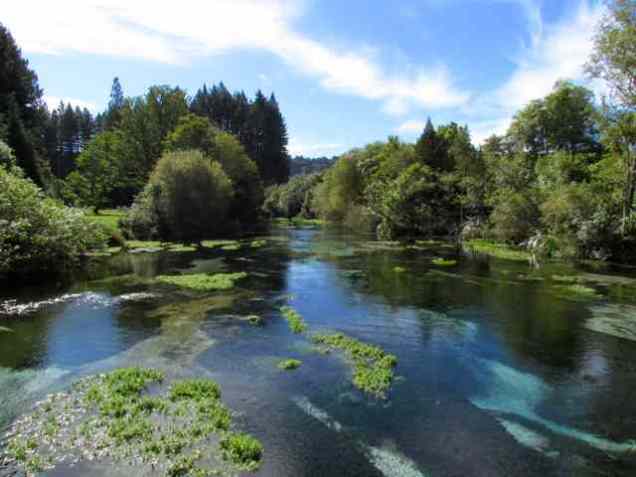 What does the Department of Conservation, a golf club, and a hapu (sub-tribe) have in common?
What does the Department of Conservation, a golf club, and a hapu (sub-tribe) have in common?
They are all partners in caring for the Hamurana Springs Reserve, on the northern shores of Lake Rotorua [click here to view location]. The hapu, Ngati Rangiwewehi, a sub-tribe of Te Arawa, has an association with the spring and the river which flows from it dating back to the 1300. The area was heavily cultivated, with gardens on both sides of the river, while the river itself was a source of food, such as koura (freshwater crayfish), and kokopu and inanga (both from the genus Galaxias). The springs also became important to the local economy as a scenic destination: from the 188os, local Maori provided guiding services and canoe transport for European visitors to the springs.
 However, like most of the land in the region, this land was purchased or otherwise obtained by the government for European settlement and development into farmland. The area around the springs has largely lost its original vegetation – though some of the exotic vegetation has become an attraction in itself. A grove of coastal redwoods (Sequoia sempervirens), native to the Pacific coast of North America, were planted alongside the river in 1919, probably by the farmer at the time [see photo right]. The tallest ones now are an impressive 55 metres high (though somewhat lesser in stature than a mature redwood, which grows up to 100 metres high).
However, like most of the land in the region, this land was purchased or otherwise obtained by the government for European settlement and development into farmland. The area around the springs has largely lost its original vegetation – though some of the exotic vegetation has become an attraction in itself. A grove of coastal redwoods (Sequoia sempervirens), native to the Pacific coast of North America, were planted alongside the river in 1919, probably by the farmer at the time [see photo right]. The tallest ones now are an impressive 55 metres high (though somewhat lesser in stature than a mature redwood, which grows up to 100 metres high).
The headspring – the largest in the North Island – bubbles up from a depth of 15 metres, and is crystal-clear. The spring water originates from the Mamaku Plateau [click here to view approximate location], from where it travels an incredible 70 years through underground aquifers, before reaching Hamurana, where it pushes up through volcanic (rhyolitic) rock. From there, it travels down the Hamurana River, into Lake Rotorua, through the Ohau Channel, to Lake Rotoiti. From there it flows down the Kaituna River out to the Pacific Ocean at Maketu [click here to view location].
On January 9th, 1957, more than 5000 pennies were found in the spring by a group of divers from Wellington. All the pennies dated from the 1860s. They were distributed to a number of children’s charities.
in the spring by a group of divers from Wellington. All the pennies dated from the 1860s. They were distributed to a number of children’s charities.
Today, the reserve is the site of a number of nature-restoration initiatives undertaken by the Department of Conservation, Ngati Rangiwewehi and the local community, including the “bioswale gardens”at the entrance of the reserve – a small wetland planted with native vegetation, which filters out impurities from water before it seeps into the river [see photo left].
Photo top: Hamurana River, from the bridge at the entrance of the Reserve. Though the river is infested by a number of exotic weeds, the water is incredibly clear. (Photos: C. Knight).
See also: Two faces of a lake – Lake Rotoiti.

The local community mentioned is actually a group of people belonging to the Hamurana Springs Incorporated Society who devote their spare time to restoring the area to its former glory.